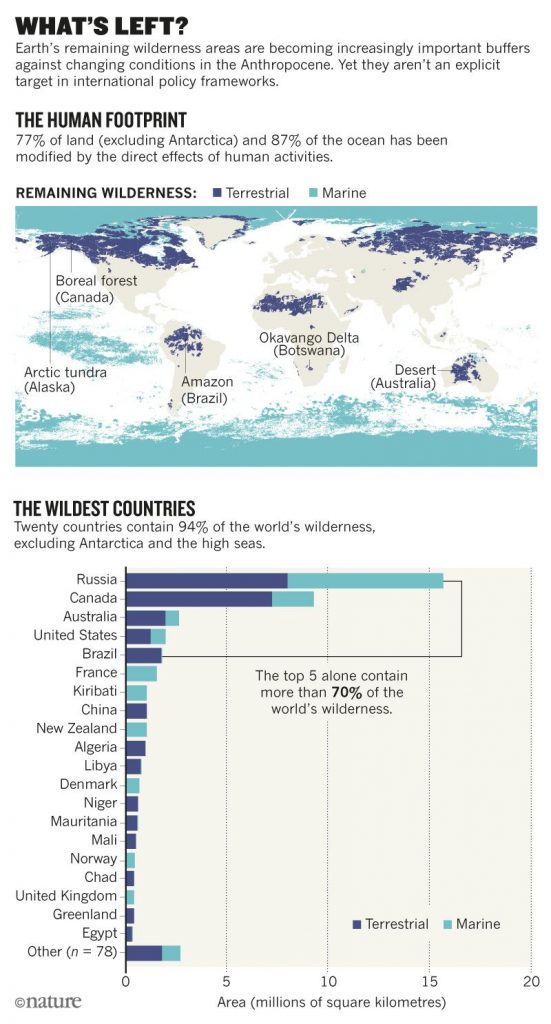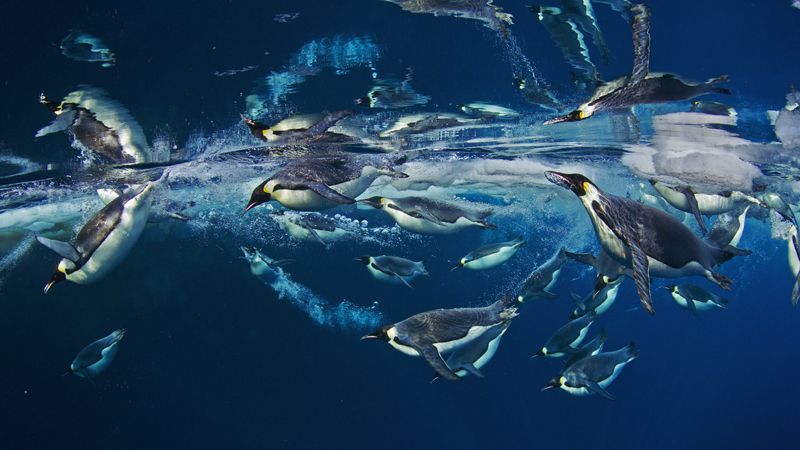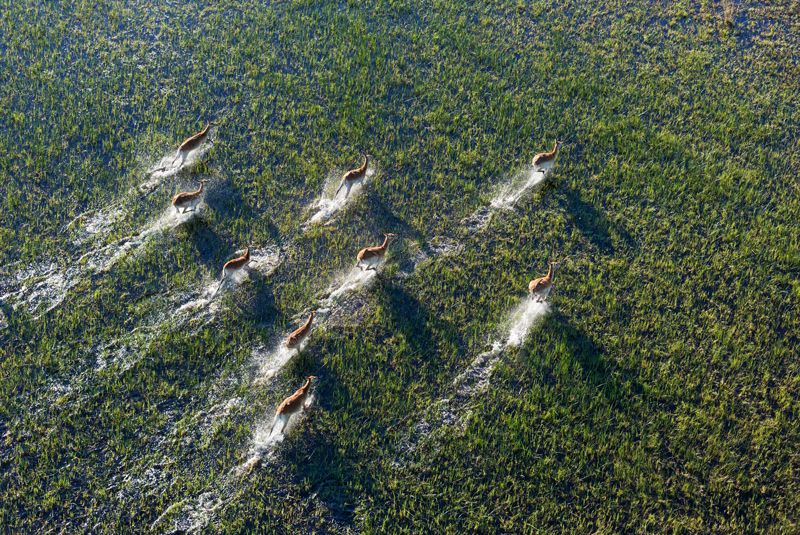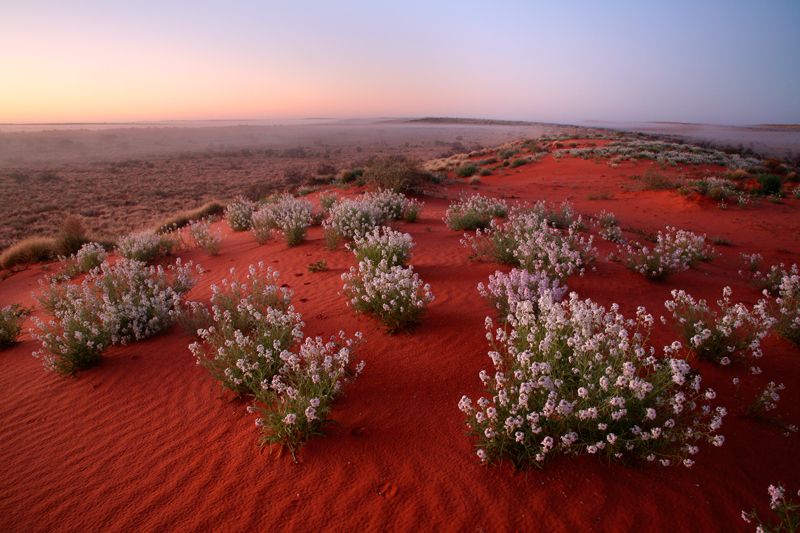Source: Nature—International Journal of Science
First map of Earth’s intact ecosystems shows just five nations are responsible for most of them – but it will require global action to protect them. The UQ and WCS study, published in the journal Nature, identifies Australia, the US, Brazil, Russia and Canada as the five countries that hold the vast majority of the world’s remaining wilderness.

Map of the world’s remaining wilderness. Green represents land wilderness, while blue represents ocean wilderness. Photograph: Nature
Just five countries hold 70% of the world’s remaining untouched wilderness areas and urgent international action is needed to protect them, according to new research.
Researchers from the University of Queensland (UQ) and the Wildlife Conservation Society (WCS) have for the first time produced a global map that sets out which countries are responsible for nature that is devoid of heavy industrial activity.
Below is an excerpt of the UQ and WCS study, published in the journal Nature
Protect the last of the wild
Global conservation policy must stop the disappearance of Earth’s few intact ecosystems, warn James E. M. Watson, James R. Allan and colleagues.
A century ago, only 15% of Earth’s surface was used to grow crops and raise livestock1. Today, more than 77% of land (excluding Antarctica) and 87% of the ocean has been modified by the direct effects of human activities2,3. This is illustrated in our global map of intact ecosystems (see ‘What’s left?’).
Between 1993 and 2009, an area of terrestrial wilderness larger than India — a staggering 3.3 million square kilometres — was lost to human settlement, farming, mining and other pressures4. In the ocean, areas that are free of industrial fishing, pollution and shipping are almost completely confined to the polar regions5.
Numerous studies are revealing that Earth’s remaining wilderness areas are increasingly important buffers against the effects of climate change and other human impacts. But, so far, the contribution of intact ecosystems has not been an explicit target in any international policy framework, such as the United Nations’ Strategic Plan for Biodiversity or the Paris climate agreement.
This must change if we are to prevent Earth’s intact ecosystems from disappearing completely.

LAST CHANCE
In 2016, we led an international team of scientists to map the world’s remaining terrestrial wilderness3,4. This year, we produced a similar map for intact ocean ecosystems2 (see ‘Wild Earth’). The results of these efforts show that time is running out to safeguard the health of the planet — and human well-being.
Some conservationists contend that particular areas in fragmented and otherwise-degraded ecosystems are more important than undisturbed ecosystems6,7. Fragmented areas might provide key services, such as tourism revenue and benefits to human health, or be rich in threatened biodiversity. Yet numerous studies are starting to reveal that Earth’s most intact ecosystems have all sorts of functions that are becoming increasingly crucial2,8,9.
WILD EARTH
To map Earth’s remaining terrestrial wilderness, we used the best available data on eight indicators of human pressures at a resolution of 1 square kilometre. These were: built environments, crop lands, pasture lands, population density, night-time lights, railways, major roadways and navigable waterways3,4. (Data were collected in 2009.) For our map of intact ocean ecosystems, we used 2013 data on fishing, industrial shipping and fertilizer run-off, among 16 other indicators2.
We identified wilderness land or ocean areas as those that were free of human pressures, with a contiguous area of more than 10,000 km2 on land.
Wilderness areas are now the only places that contain mixes of species at near-natural levels of abundance. They are also the only areas supporting the ecological processes that sustain biodiversity over evolutionary timescales10. As such, they are important reservoirs of genetic information, and act as reference areas for efforts to re-wild degraded land and seascapes.
Various analyses reveal that wilderness areas provide increasingly important refuges for species that are declining in landscapes dominated by people11. In the seas, they are the last regions that still contain viable populations of top predators, such as tuna, marlins and sharks9.
Safeguarding intact ecosystems is also key to mitigating the effects of climate change, which are making the refuge function of wilderness areas especially important. A 2009 study, for instance, showed that Caribbean coral reefs that have low levels of pollution or fishing pressure recovered from coral bleaching up to four times faster than did reefs with high levels of both12. And a 2012 global meta-analysis revealed that the impacts of climate change on ecological communities are more severe in fragmented landscapes13.
Many wilderness areas are critical sinks for atmospheric carbon dioxide. For example, the boreal forest is the most intact ecosystem on the planet and holds one-third of the world’s terrestrial carbon. And intact forested ecosystems are able to store and sequester much more carbon than are degraded ones8. In the tropics, logging and burning now accounts for up to 40% of total above-ground carbon emissions14. In the ocean, seagrass meadows that are degraded (such as by sediment pollution) switch from being carbon sinks to major carbon sources15.

Sub-Arctic vegetation in Canada. Credit: Mike Grandmaison/Getty
Moreover, models based on geography, rainfall, degree of deforestation and so on are starting to reveal the degree to which wilderness areas regulate the climate and water cycles — locally, regionally and globally. Such areas also provide a buffer against extreme weather and geological events. Simulations of tsunamis, for instance, indicate that healthy coral reefs provide coastlines with at least twice as much protection as highly degraded ones16.
Wilderness regions are home to some of the most politically and economically marginalized indigenous communities on Earth. These people (who number in the hundreds of millions) are reliant on intact marine and terrestrial ecosystems for resources such as food, water and fibre17. Many have established biological and cultural connections with their environment over millennia. Securing the wilderness is central to reducing their poverty and marginalization — and to achieving numerous UN Sustainable Development Goals, from reducing inequality to improving human well-being.
GLOBAL TARGETS
We believe that Earth’s remaining wilderness can be protected only if its importance is recognized within international policy frameworks.
Currently, some wilderness areas are protected under national legislation such as the 1964 US Wilderness Act, which protects 37,000 km2 of federal land. But in most nations, these areas are not formally defined, mapped or protected, and there is nothing to hold nations, private industry, civil society or local communities to account for their long-term conservation. What is needed is the establishment of global targets within existing international frameworks — specifically, those aimed at conserving biodiversity, avoiding dangerous climate change and achieving sustainable development.

Emperor penguins in the Ross Sea.Credit: Paul Nicklen/NGC
There are several ways to do this immediately. The carbon sequestration and storage capacities of wilderness areas could be formally documented, and the importance of conserving them written into the policy recommendations of the UN Framework Convention on Climate Change (UNFCCC). Such a move would enable nations to make the protection of wilderness areas an integral part of their strategy for reducing emissions.
As an example, under the UNFCCC process for reducing emissions from deforestation and forest degradation (REDD+), landowners can be compensated if they refrain from clearing an area of tropical forest that they’d planned to develop. However, there are no incentives for nations, private industry or communities to protect crucial carbon sinks, even when no imminent development is identified. This means that there is nothing to stop the slow erosion of these places from small-scale and often unplanned industrial activity. Similar policies are needed to protect other carbon-rich ecosystems, such as seagrass meadows, and temperate and boreal forests, especially in developed countries that do not currently receive financial support under the UNFCCC.
Later this month, Egypt will host the 14th gathering of the Conference of the Parties to the Convention on Biological Diversity (CBD). Signatory nations, intra-governmental organizations such as the International Union for Conservation of Nature (IUCN), non-governmental organizations and the scientific community will meet to work towards a strategic plan for the protection of biodiversity after 2020. We urge participants at the meeting to include a mandated target for wilderness conservation. In our view, a bold yet achievable target is to define and conserve 100% of all remaining intact ecosystems.
A mandated global target will make it easier for governments, non-governmental organizations and entities such as the Global Environment Facility (a multinational funding programme that tackles environmental and sustainability problems) to leverage funding and mobilize action on the ground.

The Ivishak River in the Arctic National Wildlife Refuge, Alaska.Credit: Danita Delimont/Getty
It will also help to enable action under the various conventions that are attempting to protect biodiversity. For example, officially recognizing the contribution that the wilderness makes to the ‘outstanding universal value’ of certain areas could lead to the designation of new Natural World Heritage Sites.
Under the UN World Heritage Convention, Natural World Heritage Sites are currently selected for their outstanding natural beauty, or because they contain unique biodiversity or ecological and geological features. The wilderness is associated with all of these criteria, but its importance has yet to be specifically acknowledged.
Almost two-thirds of marine wilderness lies in international waters, beyond the immediate control of nations. The United Nations Convention on the Law of the Sea is currently negotiating a legally binding agreement to govern high-seas conservation. Keeping Earth’s remaining marine wilderness off-limits to exploitation should be a key component of the new treaty. Strict limits on government subsidies of harmful fishing will also be crucial here; without these, more than half of high-seas industrial fishing would be unprofitable18.
Our maps exclude Antarctica because it is off-limits to direct resource exploitation such as mining, and the indirect effects of human activities there are harder to measure. But it is a crucial wilderness area that is urgently in need of protection. Antarctica’s isolation and extreme conditions have prevented the levels of degradation experienced elsewhere. But invasive species, pollution, increased human activity and, above all, climate change are threatening its unique biodiversity and its ability to regulate the global climate.
The Antarctic Treaty System’s Committee for Environmental Protection has prioritized research and action targeted at minimizing human impacts in its latest five-year plan. Signatory nations must now commit to implementing measures targeted at reducing human impacts, such as strict biosecurity procedures that minimize the risk of visitors to Antarctica introducing invasive species.

Red lechwe antelope (Kobus leche leche) in the Okavango Delta in Botswana. Credit: Thomas Dressler/Getty
Local action
How can changes in policy at the global level translate into effective national action?
By our measure, 20 countries contain 94% of the world’s remaining wilderness (excluding the high seas and Antarctica). More than 70% is in just five countries — Russia, Canada, Australia, the United States and Brazil (see ‘What’s left?’). Thus, the steps these nations take (or fail to take) to limit the expansion of roads and shipping lanes, and to rein in large-scale developments in mining, forestry, agriculture, aquaculture and industrial fishing, will be critical.
One obvious intervention that these nations can prioritize is establishing protected areas in ways that would slow the impacts of industrial activity on the larger landscape or seascape19. Given the scale of wilderness areas, however, the expansion of strictly enforced protected areas won’t suffice.
Several studies show that stopping industrial development to protect the livelihoods of indigenous people can conserve biodiversity and ecosystem services just as well as strictly protected areas can. As such, the recognition of local community rights to land ownership and management could be a key way to limit the impacts of industrial activity8.
Mechanisms that enable the private sector to protect, rather than harm, wilderness areas will be crucial. Specifically, the preservation of intact ecosystems needs to feature among lenders’ investment and performance standards, particularly for organizations such as the World Bank, the International Finance Corporation and the regional development banks. Initiatives that enable companies to declare their supply chains ‘deforestation-free’ (such as for products containing palm oil) should be expanded to help to secure more intact ecosystems.

Flowers in the Australian desert, a wilderness that is the last stronghold of many marsupial species, such as the bilby. Credit: Feargus Cooney/Getty
In the oceans, regional fisheries management organizations (RFMOs), formed by countries to manage shared fishing interests, have effectively closed large areas of the high seas. For example, the North East Atlantic Fisheries Commission (an RFMO founded in 1980) has shut more than 350,000 square kilometres of the Atlantic to bottom trawling. The power of RFMOs could be increased to enable the creation of broader, scaled-up conservation agreements for the high seas.
Wild places are facing the same extinction crisis as species. Similarly to species extinction, the erosion of the wilderness is essentially irreversible. Research has shown that the first impacts of industry on wilderness areas are the most damaging11. And once it has been eroded, an intact ecosystem and its many values can never be fully restored.
As US President Lyndon B. Johnson observed when he signed the US Wilderness Act in 1964, “If future generations are to remember us with gratitude rather than contempt … we must leave them a glimpse of the world as it was in the beginning.”
Already we have lost so much. We must grasp this opportunity to secure the wilderness before it disappears forever.







 The Top Viral YouTube Videos of 2017
The Top Viral YouTube Videos of 2017 What Does Your Face Say About Your Health?
What Does Your Face Say About Your Health? An orbiting message of peace
An orbiting message of peace Meet R.N. Ravi, who is mediating peace with the Nagas
Meet R.N. Ravi, who is mediating peace with the Nagas










Leave a Reply
Your email address will not be published. Required fields are marked (required)